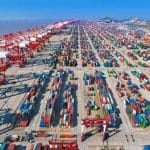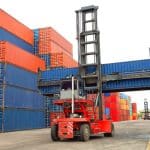OCEAN CARRIERS STEP UP NY-NJ EMPTY SWEEPS UNDER THREAT OF NEW FEE
The Port of New York and New Jersey has seen an uptick in empty container sweeps by ocean carriers after its decision to impose a tariff aimed at empty boxes lingering in the region.
PORT OF LONG BEACH SEES PANDEMIC-ERA IMPORTS SURGE EASING
The head of the second-biggest US port expects the pandemic-era surge in consumer demand that snarled supply chains will start to cool, with evidence of a deceleration already reflected in weaker inbound container arrivals. Imports into Long Beach have now fallen for two months. Meanwhile, the neighbouring port of Los Angeles registered the biggest decline in inbound cargo since the early days of the Covid-19 pandemic in August. Together, the twin operations handle about 40% of containerized trade with Asia. The most recent data show US consumer spending and retail sales rising at a sluggish pace, a sign that the hottest inflation in almost four decades is starting to take its toll on the economy. Ports had for months been overwhelmed by an influx of goods that triggered supply-chain logjams and delivery delays, but that is showing signs of abating due to logistics improvements and as interest-rate increases are starting to cool demand. Cordero and other US port directors forecast an earlier-than-normal peak season in July as retailers raced around the clock to avoid another logistics nightmare around the holidays. Despite a cool-down in the second half of the year, Long Beach is still set for a strong year, he said. Long Beach is among 29 ports on the US West Coast awaiting the outcome of labour talks between the International Longshore and Warehouse Union — which represents 22,000 dockworkers — and the Pacific Maritime Association, negotiating on behalf of more than 70 employers. The employees have been working without a contract since their previous pact expired July 1, and both sides have vowed to avoid a repeat of the 2014 negotiations, which resulted in the US facing nine months of disruptions and shipping delays that only ended after the Obama administration intervened.
PORT OF LOS ANGELES STARTING TO FEEL THE PINCH
Incoming container cargo to Port of Los Angeles declined 17% to about 404,000 units in August from a year earlier, the smallest amount in 2022. The decline reflects some diversion in cargo to East and Gulf Coast ports in order to avoid port congestion and as a possible hedge. Consumers are getting a little bit anxious as are retailers — some with elevated inventory levels have been discounting products to have more flexibility going into the fourth quarter. Port of Los Angeles is “projecting lighter numbers” for September, but it’s set for the second-busiest year in its history,
FALLING IMPORTS AT LARGEST U.S. PORT HINT AT WEAKER DEMAND
The number of containers arriving at the busiest US port of Los Angeles dropped by the most since the early days of the Covid-19 pandemic last month, an early indication that consumer demand could be starting to moderate. Inbound loaded containers to the Port of Los Angeles fell 17% — the largest decline since May 2020 — to about 404,000 units in August from the previous month, the port said Thursday. The number of imported containers was the smallest handled so far this year. Despite the declines and a projection for lighter numbers in September, Executive Director Gene Seroka said he expects 2022 to be the complex’s second-busiest year on record. Meanwhile, the neighbouring port of Long Beach handled 5.6% fewer inbound containers last month compared with a year earlier, data showed Thursday. Imports have now fallen for two straight months at the operation. Despite the cooldown, last month was still the port’s second-busiest August on record. The twin hubs of Los Angeles and Long Beach comprise the largest port complex in the US, handling about 40% of containerized trade with Asia.
MARAD ADMINISTRATOR PHILLIPS ANNOUNCES CARGO PREFERENCE COMPLIANCE INITIATIVES
MARAD Administrator Ann Phillips last week testified before the Subcommittee on Coast Guard and Maritime Transportation, announcing two initiatives intended to support federal compliance with cargo preference requirements. Cargo Preference is the general term used to describe the U.S. laws, regulations and policies that require the use of U.S.- flag vessels in the movement of cargo that is owned, procured, furnished, or financed by the U.S. Government. It also includes cargo that is being shipped under an agreement of the U.S. Government, or as part of a government program. Cargo preference is not only important for national security and defence, but also critical for sustaining and growing American shipping capacity.
Under current federal cargo preference law, the Department of Defence must move 100 percent of its cargoes on U.S.-flagged vessels. Generally, departments and agencies outside of the Department of Defence must ship at least 50 percent of the gross tonnage of the equipment, materials, or commodities that they transport on U.S.-flagged vessels. Administrator Phillips announced that MARAD will issue a Request for Information to solicit input from all stakeholders on cargo preference requirements. She also announced that MARAD will resume publishing comprehensive federal cargo preference data. Publication of the data is intended to increase interagency efficiency and to provide transparency regarding the movement of government-impelled cargo on both U.S.-flagged and foreign-flagged vessels. “Cargoes paid for by American taxpayers belong on American ships.
Cargo preference requirements are not just ‘Buy America’ requirements, they are requirements that also help to strengthen America,” Administrator Phillips testified during the recent hearing, entitled “Cargo Preference: Compliance with and Enforcement of Maritime’s Buy American Laws. ”MARAD is also working with the Biden-Harris Administration’s “Made In America Office” to help agencies understand cargo preference requirements, including communicating with all federal departments and agencies to remind them of their obligations and request that they each identify a Senior Accountable Official—consistent with OMB’s implementing guidance on Executive Order 14005, Ensuring the Future Is Made in All of America by All of America’s Workers —who can be a single point of contact with whom MARAD can work to implement cargo preference.
WITH RAIL STRIKE AVERTED, FOCUS TURNS TO CLEARING CONGESTION
US freight-rail companies need to turn their focus to clearing a backlog of containers at ports and at inland train terminals now that they have reached a tentative labour deal that averts the start of a strike by about 125,000 workers, the chief of Port of Los Angeles said. There are about 28,000 containers awaiting collection by trains at the biggest US port, a sixfold increase since February, and rail terminals in cities such as Chicago, Kansas City, Missouri, and Dallas are jammed. “Under normal conditions, that number should be zero — there’s still much more work for all of us to do with today’s announcement of the tentative agreement, everyone can now shift their focus back to the work on the ground,” he told reporters in a virtual briefing Thursday. “Getting those import containers off and into the domestic economy is key to improving rail flow at US ports.” Almost 60% of the units for pickup have been sitting on the docks for nine days or longer. After almost three years of negotiations, US freight railroads and unions reached a tentative deal early Thursday. Unions still must ratify the deal, but it marks a significant victory for President Joe Biden and Cabinet officials, who were deeply involved in the marathon negotiations. The agreement was reached after 20 consecutive hours of talks.
RAILROADS WIND DOWN SHIPMENTS AS STRIKE DEADLINE LOOMS
US railroads are poised to stop shipments of farm products and other key goods starting Thursday as the industry braces for a possible labour strike that could cost the world’s biggest economy day. Norfolk Southern Corp. said it plans to halt unit train shipments of bulk commodities on Thursday ahead of a potential US rail worker strike the following day. The railroad also said it would stop accepting autos for transit at its facilities starting Wednesday afternoon. Other railways are likely to follow suit, according to one agriculture group. “We are hearing several rail carriers are tentatively planning to wind down shipments,” said Max Fisher, chief economist at the National Grain and Feed Association, which represents most US grain handlers. A halt to shipments of grains, fertilizer, fuel and other crucial items threatens to hobble the US economy at a time of rampant inflation and fear of a prolonged global economic slump. Representatives for BNSF Railway Co. and Union Pacific Corp. also signalled they were prepared to curtail service as the deadline looms.
Chassis pools
MINNEAPOLIS / St. PAUL – Deficit on 20’, 40’ and 45’ chassis. CHICAGO – Deficit on 40’ chassis
CINCINNATI – Constrained on 20’, 40’ and 45’ chassis CLEVELAND – Constrained on 20’ chassis, Deficit on 40’ chassis COLUMBUS – Deficit on 40’ and 45’ chassis
DETRIOT – Deficit on 40’ chassis
INDIANAPOLIS – Deficit on 40’ and 45’ chassis.
LOUISVILLE – Deficit on 40’ chassis.
MEMPHIS – Constrained on 40’ chassis.
NASHVILLE – Deficit on 40’ chassis
DALLAS / Ft. WORTH – Deficit on 40’ chassis
EL PASO – Deficit on 40’ chassis.
HOUSTON – Constrained on 40’ chassis
BALTIMORE – Deficit on 40’ chassis.
NEW YORK/NEW JERSEY – Deficit on 40’ chassis. PHILADELPHIA – Deficit on 40’ chassis
KANSAS CITY – Deficit on 40’ and 45’ chassis
OMAHA – Deficit on 40’ and 45’ chassis.
St. LOUIS – Deficit 40’ and 45’ chassis.
LOS ANGELES/LONG BEACH – Constrained on 40’ chassis. DENVER – Constrained on 40’ chassis.
SALT LAKE CITY – Deficit on 40’ chassis




